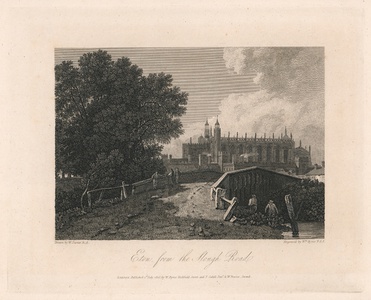| Method | Copper engraving |
| Artist | William Byrne after Joseph Mallord William Turner |
| Published | London, Published 1st. July 1803, by W. Byrne Tichfield Street and T. Cadell Junr. & W. Davies, Strand. |
| Dimensions | Image 150 x 213 mm, Plate 228 x 285 mm, Sheet 215 x 280 mm |
| Notes |
A view of Eaton from Britannia Depicta; A Series Of Views (With brief Descriptions) Of The Most Interesting And Picturesque Objects In Great Britain, Engraved From Drawings By Messrs. Farington, Turner, Hearne, Smith, Alexander, &c. - By William Byrne, F.A.S. - The Counties Alphabetically Arranged; - Part I. Containing Twenty-four Views in Bedfordshire, Berkshire, And Buckinghamshire. William Byrne (1743-1805) was a landscape engraver, and publisher who trained in Paris under Wille in the early 1760s, and then worked in London. He was father of the engravers Anne Francis, Elizabeth, John, Letitia and Mary. Joseph Mallord William Turner (1775 - 1851) was a painter and draughtsman who became one of the most celebrated artists Britain would ever produce. He was born near Covent Garden, London, and entered the Royal Academy Schools in December of 1789. The Academy, conscious of his prodigious talent, encouraged and supported Turner. He was elected as an Associate of the RA in 1799, and became a full Academician in 1802. His early oil painting flitted between Netherlandish works in the manner of Cuyp, Ruisdael and Van de Velde, classical landscapes like those of Claude and Richard Wilson, and, upon returning from his Parisian visit in 1802, grand historical compositions like those of Poussin and Titian. The development of his idiosyncratic style, commonly held to have been around 1803, led to critical condemnation. His preoccupation with light and colour produced abstract, near vorticistic works, which predated Impressionism, but were hugely controversial in the conformist context of late Georgian and early Victorian England. Whilst some critics accused Turner of extravagance and exaggeration, John Ruskin virulently thwarted these claims in Modern Painters, and championed the artist's fidelity to nature. Ruskin became the main advocate of a new generation of Turner admirers, usually professional, middle class, or newly wealthy, who embraced his work for its modernity. An enormously prolific artist, Turner bequeathed over three hundred oils and close to twenty thousand drawings and prints to the nation. His style produced many imitators, but no rivals. |
| Framing | unmounted |
| Price | £60.00 |
| Stock ID | 51825 |

